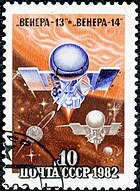Venera 13

Postage stamp of Venera 13/14
|
|
| Mission type | Venus flyby / lander |
|---|---|
| Operator | Soviet Academy of Sciences |
| COSPAR ID | 1981-106A |
| SATCAT № | 12927 |
| Spacecraft properties | |
| Spacecraft type | 4V-1 no.760 |
| Manufacturer | NPO Lavochkin |
| Launch mass | 4,397.85 kilograms (9,695.6 lb) |
| Landing mass | 760 kg (1,680 lb) |
| Dry mass | 1,643.72 kg (3,623.8 lb) |
| Start of mission | |
| Launch date | October 30, 1981, 06:04:00 UTC |
| Rocket | Proton with upper and escape stages |
| Launch site | Baikonur 200/40 |
| Flyby of Venus | |
| Spacecraft component | Venera 13 flight platform |
| Closest approach | March 1, 1982 |
| Distance | 36,000 kilometres (22,000 mi) |
| Venus lander | |
| Spacecraft component | Venera 13 descent craft |
| Landing date | 03:57:21, March 1, 1982 |
| Landing site | 7°30′S 303°00′E / 7.5°S 303°E (east of Phoebe Regio) |
Venera 13 (Russian: Венера-13 meaning Venus 13) was a probe in the Soviet Venera program for the exploration of Venus.
Venera 13 and 14 were identical spacecraft built to take advantage of the 1981 Venus launch opportunity and launched 5 days apart, Venera 13 on 30 October 1981 at 06:04:00 UTC and Venera 14 on 4 November 1981 at 05:31:00 UTC, both with an on-orbit dry mass of 760 kg.
Each mission consisted of a cruise stage and an attached descent craft.
As the cruise stage flew by Venus the bus acted as a data relay for the lander and then continued on into a heliocentric orbit. It was equipped with a gamma-ray spectrometer, UV grating monochromator, electron and proton spectrometers, gamma-ray burst detectors, solar wind plasma detectors, and two-frequency transmitters which made measurements before, during, and after the Venus flyby.
The descent lander was an hermetically-sealed pressure vessel, which contained most of the instrumentation and electronics, mounted on a ring-shaped landing platform and topped by an antenna. The design was similar to the earlier Venera 9–12 landers. It carried instruments to take chemical and isotopic measurements, monitor the spectrum of scattered sunlight, and record electric discharges during its descent phase through the Venusian atmosphere. The spacecraft utilized a camera system, an X-ray fluorescence spectrometer, a screw drill and surface sampler, a dynamic penetrometer, and a seismometer to conduct investigations on the surface.
List of lander experiments and instruments:
After launch and a four-month cruise to Venus the descent vehicle separated from the cruise stage and plunged into the Venusian atmosphere on 1 March 1982. After entering the atmosphere a parachute was deployed. At an altitude of about 50 km the parachute was released and simple airbraking was used the rest of the way to the surface.
...
Wikipedia
